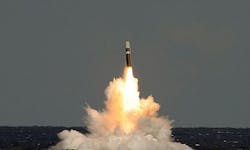Navy plans cyber security upgrades for fleet of submarine-launched nuclear missiles
Officials of the Navy Strategic Systems Programs (SSP) office in Washington are asking the Lockheed Martin Corp. Space Systems segment in Sunnyvale, Calif., for a cyber security update to information technology (IT) applications that are unique to fleet ballistic missile systems.
The order is a modification to contracts awarded last year collectively worth $419.5 million for Trident II D5 submarine-launched ballistic missile production. Friday's order includes a high-voltage detonator refresh for submarine-launched nuclear missiles.
The Trident II D5 is one of the most advanced submarine-launched atomic missiles in the world, and is the primary U.S. sea-based nuclear ballistic missile deployed aboard U.S. Navy Ohio-class ballistic missile submarines.
The U.S. Navy operates 14 of these ballistic missile submarines, each of which can carry as many as 24 Trident II missiles. Although the Trident II is designed to carry as many as 12 multiple independently targetable reentry vehicle (MIRV) warheads, current treaties reduce this number to four or five.
Each Trident II missile has a range of 4,000 to 7,000 miles. The Trident II D-5 was first deployed in 1990 and is scheduled to remain in service until at least 2027.
The Navy started the D-5 Life Extension Program in 2002 to replace obsolete components using as many commercial off-the-shelf (COTS) parts as possible to keep costs down and to enhance the missile's capability.
The Charles Stark Draper Laboratory Inc. in Cambridge, Mass., is in charge of upgrading the Trident II's guidance system, and has been working on this project since 2005.
story continues below
In practice, the Trident II missile's inertial measurement system receives targeting data from computers aboard the submarine. The inertial measurement unit then transmits signals to the D-5 flight-control computer and converts them into steering commands to keep the ballistic missile on target.
The missile's post-boost control system maneuvers the missile in flight to observe stars for the missile's celestial navigation subsystem, which updates the inertial system in flight.
Lockheed Martin also is integrating the Trident II onto the next-generation ballistic submarine designs of the U.S. and United Kingdom by adapting the Trident II missile and reentry subsystems into the common missile compartment for the Ohio replacement and United Kingdom successor programs.
The Ohio replacement is being designed to replace the Navy's fleet of Ohio-class ballistic missile submarines. The United Kingdom successor program, meanwhile, will replace the Royal Navy's fleet of Vanguard-class ballistic missile submarines.
The U.S. Navy today operates 18 Ohio-class submarines -- 14 of which carry the Trident nuclear missile, and four of which have been modified to carry conventionally armed long-range cruise missiles.
The Ohio-class submarines have been in commission since 1981, and are scheduled to be decommissioned and replaced starting in 2029. The United Kingdom Vanguard-class ballistic missile submarine has been at sea since 1993. The Royal Navy operates four Vanguard-class subs.
On Friday's contract modification Lockheed Martin will do the work cyber security IT work and high-voltage detonator refresh work in Sunnyvale, Calif.; Miamisburg, Ohio; Cape Canaveral and Orlando, Fla.; Silverdale, Wash.; and Kings Bay, Ga., and should be finished by December 2018.
For more information contact Lockheed Martin Space Systems online at www.lockheedmartin.com/us/ssc, or the Navy Strategic Systems Program office at www.ssp.navy.mil.
